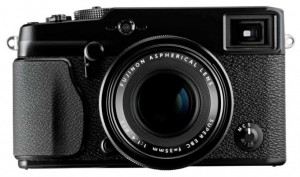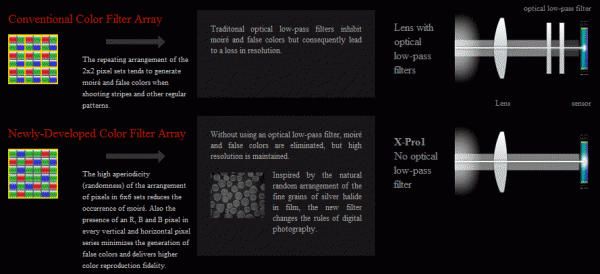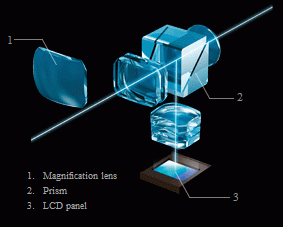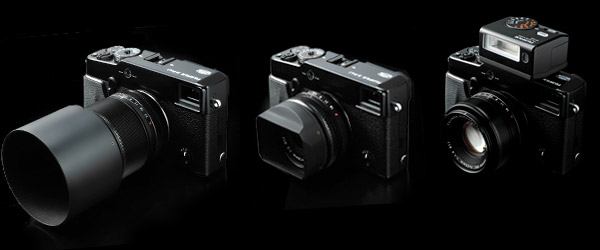 I almost let one of the recent announcements go without a second look. At first, it felt like one of those compact point-and-shoot cameras which do not really have the power to attract pro and enthusiast photographers who are the main readership here. As a matter of fact, the Fuji X-Pro 1 is rather astonishing considering its small size.
I almost let one of the recent announcements go without a second look. At first, it felt like one of those compact point-and-shoot cameras which do not really have the power to attract pro and enthusiast photographers who are the main readership here. As a matter of fact, the Fuji X-Pro 1 is rather astonishing considering its small size.
For those who know me, there is no reason for worry: There is still some time before I would convert myself from a D-SLR photo camera. But the Fuji X-Pro 1 is worth more than a cursory look.
A digital sensor
Fuji decided to build a 16-mega-pixel sensor (a nearly perfect resolution: more would not really be useful – I’m still very happy with the 12 MP of my own camera) but there is something more: The low-pass filter has been removed.
Where the vast majority of the digital sensors use a low-pass filter to wipe out all risk of moire when shooting rays and other repetitive patterns which combine themselves too easily with the regularity of the sensor, Fuji chose to move far from the most traditional “Bayer” pattern. Consequence: pixels are spread over a 6×6 matrix in a more random organization and handled by some unusual (but not overly complex) computation algorithms.

This is exactly what a good patent is about: A good idea that removes moire effect at the cost of some intelligence and without the low-pass filter which (slightly, but anyway…) reduces the quality of the raw image.

A nice viewfinder
The best of EVF (Electronic View Finder) with a nice optical viewfinder (like on the Fuji X100). Nothing to add! Fuji got it right. You want an optical view finder to have clarity of precision; It is useful to also display digital data and information organized to help the photographer.
With the right lenses, the view finder will even adapt to the focal length. Right!
The X-Pro1 lenses sold with the camera from March 2012:
- 18mm f/2 R XF
- 35mm f/1.4 R XF
- 60mm f/2 Macro 4 R XF
This is wide aperture stuff. This is good for the enthusiasts.

X mount
However, I can’t keep being annoyed by the habit of having a different lens family for each brand and each camera family (this is so common…) because it’s possible and slightly useful in theory. But customers will have to wait for the range to build itself and… never reach optimal range of options.
Accessories
An optional grip (HG-XPro1) improves handling comfort. A flash (EF-X20) brings more light when it’s scarce since the Fuji X-Pro 1 does not have built-in flash.
Picture files
the files produced by the Fuji X-Pro 1 can be in RAW format that allows more flexibility than the JPEG format. This will be good for most (if not all) serious photographers.
Promotional videos
Press Release
Fujifilm is proud to announce the new model changes the rules in the new interchangeable lens system: Fujifilm X-Pro1. This camera is aimed at a professional audience and advanced amateurs and incorporates advanced technologies such as Trans-X’s unique sensor CMOSTM megapixel APS-C 16, a new X port for mounting the lens, a viewfinder and three hybrid optical the base.
X-Pro1 sets new standards in image resolution
For this camera, Fujifilm has developed a new CMOS sensor called X-TransTM CMOSTM which is able to provide a response similar to that of a sensor “full frame”.
The new array (CFA – Color Filter Array) opens the way for an ideal sensor that does not require an optical low-pass filter. This filter is in fact essential for the reduction of false colors and moiré generated by conventional sensors, but at the same time, also degrades the resolution. Fujifilm has developed a new matrix that is inspired by the CFA random arrangement of the grain in the film, eliminating the need for optical low-pass filter to solve the problems of false colors and moiré. In the matrix, RGB pixels are arranged in groups of 6×6 pixels with high aperiodicity (randomness).
Increasing the degree of randomness eliminates the root cause of the false color and moiré, a problem that occurs in conventional matrix elements during the filming of rows and other repeating patterns. The presence of a pixel R, G and B in each series of horizontal and vertical pixels minimizes the generation of false colors and provides superior color reproduction themselves.
The use of a matrix inspired by the film has necessitated a more powerful processor to process image data for this FUJIFILM EXR Processor Pro has created this project to optimize the potential of the Trans-X sensor CMOSTM providing high speed and high-precision image processing.
Fujinon XF for the best image quality
The Fujinon lenses used for television broadcasts and medium format cameras, have always been associated with high image quality. All the experience in the design of the optics has been used in the study phase of the objectives dedicated to X-Pro1.
The targets are launched with the machine, and three are part of the new XF series Fujinon: “XF 18mm F2 R”, “XF 35mm F1, 4 R” and “R XF 60mm F2 Macro 4″. These objectives are compact, very bright and offer precise control over depth of field effect and the possibility out-of-focus bokeh thanks to the design of the curved blades of the diaphragm. The slats are curved to create a circular image at all apertures, while the edges of each blade is carefully rounded for a sharper image.
The feeling of solidity and the precise mechanics of optics will satisfy the desire of photographers to capture multiple images with every shot.
FUJIFILM Attack “X-Mount” to maximize performance
Designed specifically to maximize the design “mirrorless” of the body, X-mount flange has a short distance posterior to the sensor plane, equal to only 17.7 mm. This means that the rear lens as close as possible to the sensor. The wide opening allows you to attach the lens deeper inside the body – up to about 7.5 mm from the mounting surface – minimizing the distance of “back focus” of each lens for high resolution to the edge of the image.
Hybrid Multi Viewfinder
FUJIFILM’s revolutionary hybrid viewfinder appeared first in the X100. With its ability to instantly switch between optical viewfinder and an electronic viewfinder, the viewfinder hybrid has added a new dimension to the pleasure of composing photographs.
The user may choose to use, depending on your mood or need, depending on the optical viewfinder for a picture as real as possible and have all the information electronically in real time. The advantage of hybrid viewfinder is the ability to combine the two technologies to get the ultimate in visual quality and functionality, allowing you to place the composition of images through a bright viewfinder and offering the ability to overlay important information for the release of photos. The change from a crosshair to another is easy, thanks to the switch on the front of the body of the X-Pro1.
When mounting a Fujinon lens on the X Series XF-Pro1 in the viewfinder magnification and size of the light frame automatically change to support its focal length. The viewfinder magnification, equal to 0.37 for x and 0.60 x 18mm lens for the 35mm and 60mm, allows you to compose the scene with the brilliant optical clarity and sharpness of an image. The X-Pro1 also gives the freedom to manually set the focal distance and switch to another magnification of the viewfinder.
Technology and careful design
The top and bottom made of aluminum alloy die-cast and hand enameled precise engravings on the top and the camera lens, point to the fact that all the X-Pro1 is built with attention to detail and uncompromising quality .
This attention to detail extends to dial in shutter speed and exposure compensation control, precisely machined from solid metal. In addition, the locking mechanism and the shutter switch exposure compensation set back, are designed to prevent accidental change of settings. The edges of the selectors have a knurled finish, knurled detail, for a grip and an excellent feeling.
The seal “Made in Japan” also present on the body of the new X-PRO1, confirming that each part of the building meets the highest standards FUJIFILM.
The lens hood with precision knurled aluminum, supplied with the lens is designed exclusively for Fujinon XF. The hood is compact and lightweight and offers excellent performance with a design that perfectly matches the style of X-Pro1.
The diameter of the aperture ring and focus of the three interchangeable lenses Fujinon XF is only slightly larger than the diameter of the objective to standardize the elegant design. The precise machining of the metal, the reassuring click each picture to the aperture ring and a comfortable pair of resistance when using manual focus, contributing together to improve the shooting experience.
The coating of X-Pro1 was designed to be weather resistant and provide a look of quality. The body of X-Pro1 was designed for the complete comfort of the photographer, the natural form of the eyepiece also provides excellent protection from light. The viewfinder you can use an additional lens (optional) for diopter adjustment.
Fujifilm continues the myth of the films
Further improvements have been made to the options Film Simulation Mode with the new “Professional Color Negative Film Modes” (Pro Neg. Neg Standard and Pro. Hi) designed for users who work in the studio with the X-Pro1. If you want to take the same scene in different film simulation modes, X-Pro1 offers the option of bracketing “Film Simulation”, along with AE Bracketing, Dynamic and ISO.
Fujifilm has also included the Film Simulation mode by which X-Pro1 simulates the color and tonal qualities of popular FUJIFILM emulsions. These include the colors of Velvia, the skin tones soft and natural look of the ASTIA TEST.
Pro1-X allows you to use special color filters to expand the photographic interpretation: to increase the contrast with the yellow and red filter, make brighter green and red filter with the deepest green. Just as professional photographers when selecting a filter paper and printing to complement their creative vision, now you can easily adjust the image quality with these filters. For those who wish to achieve a more nostalgic is also a sepia filter.
Through advanced digital processing, X-Pro1 is able to simulate the multiple-exposure technique: simply select this mode and the first shot. In the hybrid viewfinder or LCD you can see what the end result and then framing the precise second shot.
A series of exclusive accessories
The handle HG-XPro1 optional, helps balance the weight of the camera, allowing a more comfortable grip and offers a uniform look to the lines of X-Pro1.
The Flash EF-X20 option, to be mounted on the hot shoe is designed as a complementary accessory to the X-Pro1. A switch lets you choose between two modes: AUTO, which automatically optimizes the flash to daylight for outdoor and indoor shooting in low light; MANUAL for manual control. In addition, the built-in speaker, easy to use, it helps to soften the effect of excessive contrast created by the flash.
The leather case LC-XPro1 optional *, X-shaped to protect Pro1, is designed to allow quick access to the camera. Particular attention was paid to every detail: the red interior that contrasts with the black leather exterior, the accuracy of the stitching and the adoption of a magnet hidden for closure. This beautiful case is completed with the inclusion of a genuine leather strap and a protective cap bellows for different optics.
Filter Protector and Protector Filter φ39mm φ52mm optional protective filters are dedicated to the new XF goals. Super EBC treatment of these filters effectively reduces reflected light. The ring of the filter, made with a special process, fits the overall design of the optics.
Fujifilm and X-lenses Pro1 18mm F2 R XF, XF 35mm F1, 4 R and R XF 60mm F2 Macro 4 will be on sale from March 2012.
Key Features
- New CMOS sensor called X-TransTM CMOSTM
- New EXR Processor Pro
- Three Fujinon dedicated XF
- FUJIFILM Attack “X-Mount”
- Hybrid Multi Viewfinder
- Sensor Cleaning System Ultra Sonic Vibration
- RAW files
- Full HD video and stereo audio
- Shutter: Focal Plane Shutter
- “Made in Japan” extremely accurate
- Film Simulation Mode Advanced
- Range of optional accessories dedicated